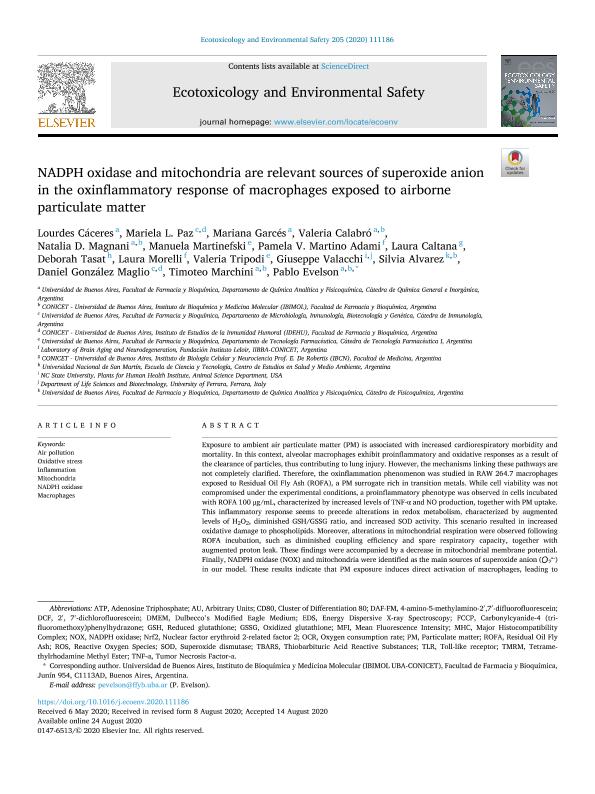Artículo
NADPH oxidase and mitochondria are relevant sources of superoxide anion in the oxinflammatory response of macrophages exposed to airborne particulate matter
Cáceres, Lourdes; Paz, Mariela Laura ; Garcés, Mariana; Calabró López, María Valeria
; Garcés, Mariana; Calabró López, María Valeria ; Magnani, Natalia Daniela
; Magnani, Natalia Daniela ; Martinefski, Manuela; Martino Adami, Pamela Victoria
; Martinefski, Manuela; Martino Adami, Pamela Victoria ; Caltana, Laura Romina
; Caltana, Laura Romina ; Tasat, Deborah; Morelli, Laura
; Tasat, Deborah; Morelli, Laura ; Tripodi, Valeria Paula
; Tripodi, Valeria Paula ; Valacchi, Giuseppe; Alvarez, Silvia
; Valacchi, Giuseppe; Alvarez, Silvia ; Gonzalez Maglio, Daniel Horacio
; Gonzalez Maglio, Daniel Horacio ; Marchini, Timoteo Oscar
; Marchini, Timoteo Oscar ; Evelson, Pablo Andrés
; Evelson, Pablo Andrés
 ; Garcés, Mariana; Calabró López, María Valeria
; Garcés, Mariana; Calabró López, María Valeria ; Magnani, Natalia Daniela
; Magnani, Natalia Daniela ; Martinefski, Manuela; Martino Adami, Pamela Victoria
; Martinefski, Manuela; Martino Adami, Pamela Victoria ; Caltana, Laura Romina
; Caltana, Laura Romina ; Tasat, Deborah; Morelli, Laura
; Tasat, Deborah; Morelli, Laura ; Tripodi, Valeria Paula
; Tripodi, Valeria Paula ; Valacchi, Giuseppe; Alvarez, Silvia
; Valacchi, Giuseppe; Alvarez, Silvia ; Gonzalez Maglio, Daniel Horacio
; Gonzalez Maglio, Daniel Horacio ; Marchini, Timoteo Oscar
; Marchini, Timoteo Oscar ; Evelson, Pablo Andrés
; Evelson, Pablo Andrés
Fecha de publicación:
12/2020
Editorial:
Academic Press Inc Elsevier Science
Revista:
Ecotoxicology and Environmental Safety
ISSN:
0147-6513
Idioma:
Inglés
Tipo de recurso:
Artículo publicado
Clasificación temática:
Resumen
Exposure to ambient air particulate matter (PM) is associated with increased cardiorespiratory morbidity and mortality. In this context, alveolar macrophages exhibit proinflammatory and oxidative responses as a result of the clearance of particles, thus contributing to lung injury. However, the mechanisms linking these pathways are not completely clarified. Therefore, the oxinflammation phenomenon was studied in RAW 264.7 macrophages exposed to Residual Oil Fly Ash (ROFA), a PM surrogate rich in transition metals. While cell viability was not compromised under the experimental conditions, a proinflammatory phenotype was observed in cells incubated with ROFA 100 μg/mL, characterized by increased levels of TNF-α and NO production, together with PM uptake. This inflammatory response seems to precede alterations in redox metabolism, characterized by augmented levels of H2O2, diminished GSH/GSSG ratio, and increased SOD activity. This scenario resulted in increased oxidative damage to phospholipids. Moreover, alterations in mitochondrial respiration were observed following ROFA incubation, such as diminished coupling efficiency and spare respiratory capacity, together with augmented proton leak. These findings were accompanied by a decrease in mitochondrial membrane potential. Finally, NADPH oxidase (NOX) and mitochondria were identified as the main sources of superoxide anion ([Formula presented]) in our model. These results indicate that PM exposure induces direct activation of macrophages, leading to inflammation and increased reactive oxygen species production through NOX and mitochondria, which impairs antioxidant defense and may cause mitochondrial dysfunction.
Archivos asociados
Licencia
Identificadores
Colecciones
Articulos(IBCN)
Articulos de INST.DE BIOLO.CEL.Y NEURCS."PROF.E.DE ROBERTIS"
Articulos de INST.DE BIOLO.CEL.Y NEURCS."PROF.E.DE ROBERTIS"
Articulos(IBIMOL)
Articulos de INSTITUTO DE BIOQUIMICA Y MEDICINA MOLECULAR
Articulos de INSTITUTO DE BIOQUIMICA Y MEDICINA MOLECULAR
Articulos(IDEHU)
Articulos de INST.DE EST.DE LA INMUNIDAD HUMORAL PROF.R.A.MARGNI
Articulos de INST.DE EST.DE LA INMUNIDAD HUMORAL PROF.R.A.MARGNI
Articulos(IIBBA)
Articulos de INST.DE INVEST.BIOQUIMICAS DE BS.AS(I)
Articulos de INST.DE INVEST.BIOQUIMICAS DE BS.AS(I)
Articulos(OCA HOUSSAY)
Articulos de OFICINA DE COORDINACION ADMINISTRATIVA HOUSSAY
Articulos de OFICINA DE COORDINACION ADMINISTRATIVA HOUSSAY
Citación
Cáceres, Lourdes; Paz, Mariela Laura; Garcés, Mariana; Calabró López, María Valeria; Magnani, Natalia Daniela; et al.; NADPH oxidase and mitochondria are relevant sources of superoxide anion in the oxinflammatory response of macrophages exposed to airborne particulate matter; Academic Press Inc Elsevier Science; Ecotoxicology and Environmental Safety; 205; 12-2020; 1-13
Compartir
Altmétricas



